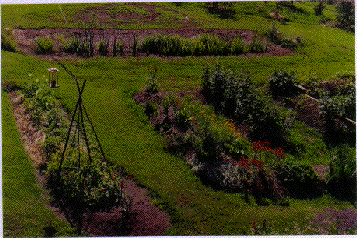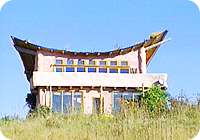

| Case studies | ||
| The greywater strategy employed by the Conyers is generally considered a simple pass-through system, that is the graywater moves via subsurface flow through the series of constructed wetlands and then percolates into the soil. | ||
| The design contains components of a typical septic system but functions dramatically different. The graywater is sent to a typical septic tank, where the majority of solids and fats settle out. The partially filtered water then flows out along a series of lined trenches filled with wetland plants and drain rock (see below). This portion allows the water to come in contact with the wetland plant roots, which uptake the nitrogen and phosphorous (see below). | ||
 |
||
| This portion allows the water to come in contact with the wetland plant roots, which uptake the nitrogen and phosphorous . | ||
 |
||
|
Conyer's drainfield
|
||
| After the first lined portion, the near-clean water then continues to flow out of the system, but now in an unlined portion where the water percolates into the soil (see conyers1.jpg). | ||
 |
||
| Testing of the system is demonstrates that the graywater is effectively cleaned and suitable for re-use to some degree. | ||
| 2020 Engineering has plans to construct other systems that will re-use the water for duckweed cultivation, which can be harvested for either compost or animal feed. | ||
| For further
information:
2020 Engineering, Inc.: www.2020engineering.com |
||